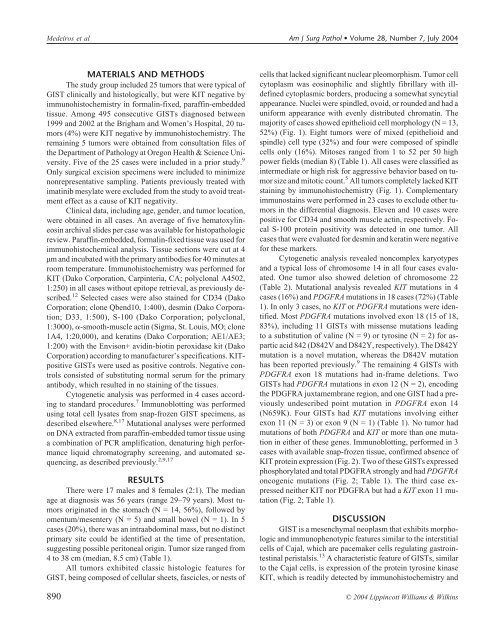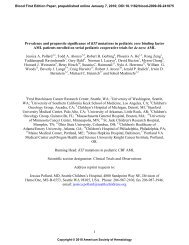KIT-negative gastrointestinal stromal tumors: proo... - ResearchGate
KIT-negative gastrointestinal stromal tumors: proo... - ResearchGate
KIT-negative gastrointestinal stromal tumors: proo... - ResearchGate
Create successful ePaper yourself
Turn your PDF publications into a flip-book with our unique Google optimized e-Paper software.
Medeiros et al Am J Surg Pathol • Volume 28, Number 7, July 2004<br />
MATERIALS AND METHODS<br />
The study group included 25 <strong>tumors</strong> that were typical of<br />
GIST clinically and histologically, but were <strong>KIT</strong> <strong>negative</strong> by<br />
immunohistochemistry in formalin-fixed, paraffin-embedded<br />
tissue. Among 495 consecutive GISTs diagnosed between<br />
1999 and 2002 at the Brigham and Women’s Hospital, 20 <strong>tumors</strong><br />
(4%) were <strong>KIT</strong> <strong>negative</strong> by immunohistochemistry. The<br />
remaining 5 <strong>tumors</strong> were obtained from consultation files of<br />
the Department of Pathology at Oregon Health & Science University.<br />
Five of the 25 cases were included in a prior study. 9<br />
Only surgical excision specimens were included to minimize<br />
nonrepresentative sampling. Patients previously treated with<br />
imatinib mesylate were excluded from the study to avoid treatment<br />
effect as a cause of <strong>KIT</strong> negativity.<br />
Clinical data, including age, gender, and tumor location,<br />
were obtained in all cases. An average of five hematoxylineosin<br />
archival slides per case was available for histopathologic<br />
review. Paraffin-embedded, formalin-fixed tissue was used for<br />
immunohistochemical analysis. Tissue sections were cut at 4<br />
µm and incubated with the primary antibodies for 40 minutes at<br />
room temperature. Immunohistochemistry was performed for<br />
<strong>KIT</strong> (Dako Corporation, Carpinteria, CA; polyclonal A4502,<br />
1:250) in all cases without epitope retrieval, as previously described.<br />
12 Selected cases were also stained for CD34 (Dako<br />
Corporation; clone Qbend10, 1:400), desmin (Dako Corporation;<br />
D33, 1:500), S-100 (Dako Corporation; polyclonal,<br />
1:3000), -smooth-muscle actin (Sigma, St. Louis, MO; clone<br />
1A4, 1:20,000), and keratins (Dako Corporation; AE1/AE3;<br />
1:200) with the Envison+ avidin-biotin peroxidase kit (Dako<br />
Corporation) according to manufacturer’s specifications. <strong>KIT</strong>positive<br />
GISTs were used as positive controls. Negative controls<br />
consisted of substituting normal serum for the primary<br />
antibody, which resulted in no staining of the tissues.<br />
Cytogenetic analysis was performed in 4 cases according<br />
to standard procedures. 7 Immunoblotting was performed<br />
using total cell lysates from snap-frozen GIST specimens, as<br />
described elsewhere. 8,17 Mutational analyses were performed<br />
on DNA extracted from paraffin-embedded tumor tissue using<br />
a combination of PCR amplification, denaturing high performance<br />
liquid chromatography screening, and automated sequencing,<br />
as described previously. 2,9,17<br />
RESULTS<br />
There were 17 males and 8 females (2:1). The median<br />
age at diagnosis was 56 years (range 29–79 years). Most <strong>tumors</strong><br />
originated in the stomach (N = 14, 56%), followed by<br />
omentum/mesentery (N = 5) and small bowel (N = 1). In 5<br />
cases (20%), there was an intraabdominal mass, but no distinct<br />
primary site could be identified at the time of presentation,<br />
suggesting possible peritoneal origin. Tumor size ranged from<br />
4 to 38 cm (median, 8.5 cm) (Table 1).<br />
All <strong>tumors</strong> exhibited classic histologic features for<br />
GIST, being composed of cellular sheets, fascicles, or nests of<br />
cells that lacked significant nuclear pleomorphism. Tumor cell<br />
cytoplasm was eosinophilic and slightly fibrillary with illdefined<br />
cytoplasmic borders, producing a somewhat syncytial<br />
appearance. Nuclei were spindled, ovoid, or rounded and had a<br />
uniform appearance with evenly distributed chromatin. The<br />
majority of cases showed epithelioid cell morphology (N = 13,<br />
52%) (Fig. 1). Eight <strong>tumors</strong> were of mixed (epithelioid and<br />
spindle) cell type (32%) and four were composed of spindle<br />
cells only (16%). Mitoses ranged from 1 to 52 per 50 high<br />
power fields (median 8) (Table 1). All cases were classified as<br />
intermediate or high risk for aggressive behavior based on tumor<br />
size and mitotic count. 5 All <strong>tumors</strong> completely lacked <strong>KIT</strong><br />
staining by immunohistochemistry (Fig. 1). Complementary<br />
immunostains were performed in 23 cases to exclude other <strong>tumors</strong><br />
in the differential diagnosis. Eleven and 10 cases were<br />
positive for CD34 and smooth muscle actin, respectively. Focal<br />
S-100 protein positivity was detected in one tumor. All<br />
cases that were evaluated for desmin and keratin were <strong>negative</strong><br />
for these markers.<br />
Cytogenetic analysis revealed noncomplex karyotypes<br />
and a typical loss of chromosome 14 in all four cases evaluated.<br />
One tumor also showed deletion of chromosome 22<br />
(Table 2). Mutational analysis revealed <strong>KIT</strong> mutations in 4<br />
cases (16%) and PDGFRA mutations in 18 cases (72%) (Table<br />
1). In only 3 cases, no <strong>KIT</strong> or PDGFRA mutations were identified.<br />
Most PDGFRA mutations involved exon 18 (15 of 18,<br />
83%), including 11 GISTs with missense mutations leading<br />
to a substitution of valine (N = 9) or tyrosine (N = 2) for aspartic<br />
acid 842 (D842V and D842Y, respectively). The D842Y<br />
mutation is a novel mutation, whereas the D842V mutation<br />
has been reported previously. 9 The remaining 4 GISTs with<br />
PDGFRA exon 18 mutations had in-frame deletions. Two<br />
GISTs had PDGFRA mutations in exon 12 (N = 2), encoding<br />
the PDGFRA juxtamembrane region, and one GIST had a previously<br />
undescribed point mutation in PDGFRA exon 14<br />
(N659K). Four GISTs had <strong>KIT</strong> mutations involving either<br />
exon 11 (N = 3) or exon 9 (N = 1) (Table 1). No tumor had<br />
mutations of both PDGFRA and <strong>KIT</strong> or more than one mutation<br />
in either of these genes. Immunoblotting, performed in 3<br />
cases with available snap-frozen tissue, confirmed absence of<br />
<strong>KIT</strong> protein expression (Fig. 2). Two of these GISTs expressed<br />
phosphorylated and total PDGFRA strongly and had PDGFRA<br />
oncogenic mutations (Fig. 2; Table 1). The third case expressed<br />
neither <strong>KIT</strong> nor PDGFRA but had a <strong>KIT</strong> exon 11 mutation<br />
(Fig. 2; Table 1).<br />
DISCUSSION<br />
GIST is a mesenchymal neoplasm that exhibits morphologic<br />
and immunophenotypic features similar to the interstitial<br />
cells of Cajal, which are pacemaker cells regulating <strong>gastrointestinal</strong><br />
peristalsis. 13 A characteristic feature of GISTs, similar<br />
to the Cajal cells, is expression of the protein tyrosine kinase<br />
<strong>KIT</strong>, which is readily detected by immunohistochemistry and<br />
890 © 2004 Lippincott Williams & Wilkins



